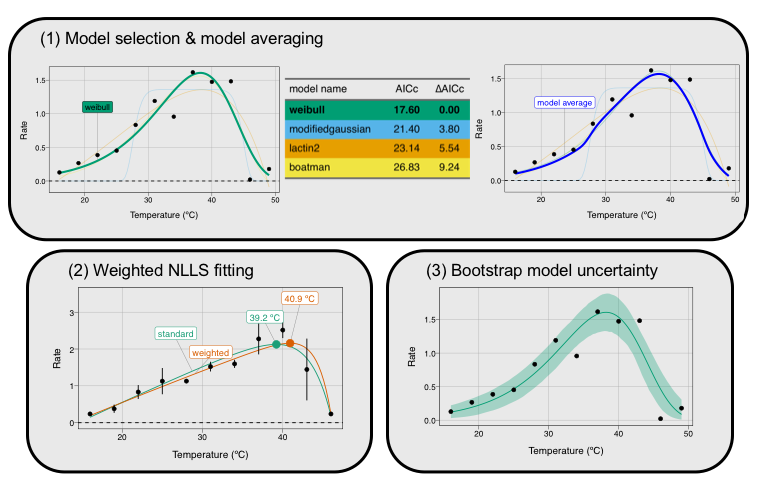

rTPC is an R package that helps fit thermal performance curves (TPCs) in R. rTPC contains 24 model formulations previously used to fit TPCs and has helper functions to help set sensible start parameters, upper and lower parameter limits and estimate parameters useful in downstream analyses, such as cardinal temperatures, maximum rate and optimum temperature.
The idea behind rTPC is to make fitting thermal performance curves easier, to provide workflows and examples of fitting TPCs without saying which model works best. Which model and which workflow is “best” is going to be down to the question that is being asked. Throughout the vignettes, Things to consider sections give some key considerations about what to consider before and during the analysis.
When developing rTPC, we made a conscious decision not to repeat code and methods that are already optimised and available in the R ecosystem. Consequently, the workflows take advantage of nls.multstart for fitting non-linear least squares regression and packages from the tidyverse for data manipulation, fitting multiple models, and visualisation. The R package car is used extensively for the bootstrapping approaches.
rTPC and the pipelines outlined in the vignettes are published in Methods in Ecology and Evolution and are open access. If this R package helps you, please cite us using the following citation:
Daniel Padfield, Hannah O’Sullivan, & Samraat Pawar (2021). rTPC and nls.multstart: A new pipeline to fit thermal performance curves in R. Methods in Ecology and Evolution. https://doi.org/10.1111/2041-210X.13585
Please report any bugs and suggestions to the Issues or email d.padfield@exeter.ac.uk. This could be requests for the inclusion of a new mathematical model formulation.
rTPC can easily be downloaded from GitHub using the
remotes::install_github(). The vignettes are all available
online, but if you would like to build them locally, add
build_vignettes = TRUE into your
install_github() command. However, we do not recommend
doing this due to the number of extra R packages utilised in the
vignettes.
# install package from GitHub
remotes::install_github("padpadpadpad/rTPC")rTPC makes it easy to fit multiple models to multiple thermal performance curves.

Figure 1. General pipeline for fitting thermal performance curves using rTPC. (1) Collect, check, and manipulate data into long format. (2) Choose which models from rTPC are going to be used. Here, a random assortment of four models were chosen. (3) Fit the models to data using nls.multstart and helper functions from rTPC. (4) Models can be visualised and (5) common traits of TPCs can be estimated using rTPC::calc_params(). (6) This simple pipeline can easily be scaled up to be used on multiple curves.
rTPC can also be easily used to do a number of common tasks needed when fitting TPCs, such as model selection, model averaging, incorporating model weights and bootstrapping of model fits.

Figure 2. Potential applications for fitting thermal performance curves using rTPC. (1) AIC, BIC or other metrics of model fit can be calculated to help to allow model selection or model averaging. (2) If TPCs are being fit to averages of multiple replicates, then weighted NLLS can be used that reduce parameter bias. (3) After the model has been fitted, non-parametric bootstrapping approaches can help estimate model uncertainty and calculate confidence intervals of parameters.
vignette("rTPC")vignette("fit_many_models") and
vignette("fit_many_curves").vignette("model_averaging_selection"),
vignette("model_weighting"),
vignette("bootstrapping_models"),
vignette("weighted_bootstrapping"), and
vignette("bootstrapping_many_curves").